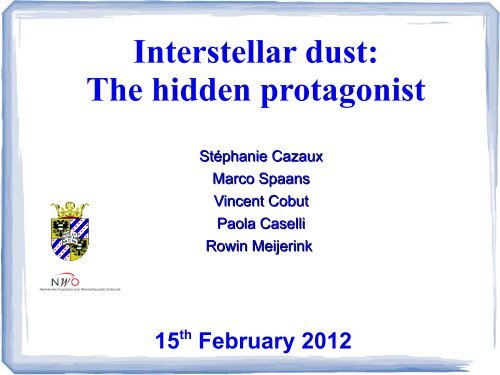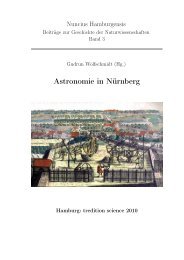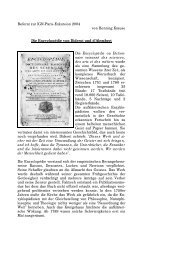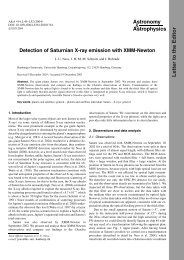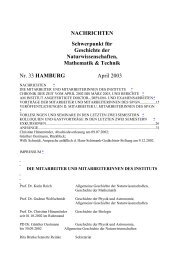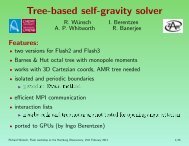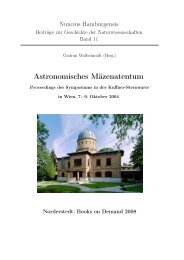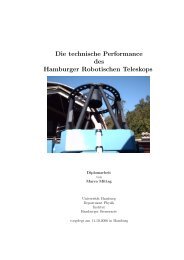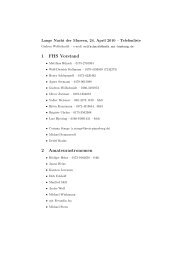Interstellar dust
Interstellar dust
Interstellar dust
You also want an ePaper? Increase the reach of your titles
YUMPU automatically turns print PDFs into web optimized ePapers that Google loves.
<strong>Interstellar</strong> <strong>dust</strong>:<br />
The hidden protagonist<br />
Stéphanie Cazaux<br />
Marco Spaans<br />
Vincent Cobut<br />
Paola Caselli<br />
Rowin Meijerink<br />
15 th February 2012
Overview<br />
Star form in clouds made of gas + <strong>dust</strong><br />
Catalyst: Enrich gas<br />
H 2<br />
,H 2<br />
O, O 2<br />
, H 2<br />
O 2<br />
Reservoir:<br />
Stealing the gas<br />
Formation of ices<br />
Impact of <strong>dust</strong> on the gas? Impact of <strong>dust</strong> on star formation?
Dust as catalyst/ reservoir<br />
H 2<br />
in MW NOT explained by gas phase reactions : Grain Gould & Salpeter 1963<br />
In the MW, H 2<br />
formation <strong>dust</strong> >> gas<br />
Reaction exothermic → products gas<br />
H 2<br />
(60-70 %)<br />
Extinction Av ~3<br />
Gas phase species → <strong>dust</strong> and make ices<br />
Hollenbach et al. 2009 ApJ, 690, 1497
Dust as catalyst:<br />
H 2<br />
observations<br />
Diffuse clouds<br />
Planetary Nebulae<br />
Dying stars<br />
Supernovae remnants<br />
T grain<br />
= 40-80K<br />
T gas<br />
< 6000K<br />
T grain<br />
~ 20K<br />
T gas<br />
~ 100K<br />
T grain<br />
~ 125K<br />
T gas<br />
~ 1000K<br />
Photodissociation Regions<br />
T grain<br />
=10 - 100K<br />
T gas<br />
= 300 - 1000K<br />
PAHs<br />
Newly born stars<br />
T grain<br />
~ 70K<br />
T gas<br />
= 1500 - 2000K<br />
Active galactic nuclei<br />
CO H 2<br />
T grain<br />
= 15- 70K<br />
T gazs<br />
~ 2000K<br />
H 2<br />
forms for a wide range of physical conditions
Dust as a reservoir:<br />
interstellar ices<br />
CO depleted from the gas<br />
H 2<br />
O ices absorption in embedded<br />
protostars (VLT-ISAAC)
Dust as reservoir:<br />
interstellar ices
<strong>Interstellar</strong> <strong>dust</strong> grains<br />
Grain size distribution<br />
PAHs<br />
Amorphous carbon<br />
Weingartner & Draine 2001<br />
Mathis, Rumpl & Nordsieck 1977<br />
DUST= Silicates, Amorphous carbon, PAHs<br />
PAHs = 50% of surface available for chemistry
Formation of molecules on <strong>dust</strong><br />
1) Interactions atom/surface<br />
Experiments: TPD<br />
Ab-initio calculations<br />
2) Mobility on the surface<br />
Rate equations and Monte carlo simulations<br />
Comparison with observations
Interaction atom/surface:<br />
experiments<br />
Experiments on graphite, amorphous carbon, silicates<br />
Pirronello et al. 1997, 1999, Zecho et al. 2002, Perets et al. 2007, Vidali et al. 2007<br />
En<br />
Amorphous Carbon<br />
Low temp., Tsurf = 5 K<br />
192s<br />
96s<br />
48s<br />
24s<br />
Physisorption<br />
Van der Waals<br />
Chemisorption<br />
covalent<br />
Graphite<br />
High temp., Tsurf = 150 K
Model:<br />
Interaction and mobility<br />
Energy<br />
600K<br />
Distance from the<br />
surface<br />
Transmission coefficient of the barriers<br />
mobility of H and D atoms<br />
Physisorption<br />
Chemisorption<br />
3Å<br />
Physisorption + chemisorption<br />
tunnel + thermal hopping
Model:<br />
Interaction and mobility<br />
physisorbed H atoms<br />
physisorbed D atoms<br />
chemisorbed H atoms<br />
chemisorbed D atoms<br />
H2<br />
HD<br />
D2<br />
En<br />
Gr<br />
Si<br />
AC<br />
Mechanisms:<br />
LH<br />
ER<br />
Physisorption<br />
Van der Waals<br />
Chemisorption
Rate equations and<br />
Monte Carlo simulations.<br />
Rate equations Monte Carlo<br />
D<br />
H<br />
Follow populations<br />
Big grains → always 1 species<br />
Follow each species<br />
small grains<br />
random accretion and<br />
random walk<br />
detail characteristic of<br />
the surface → para sites
Formation of H 2<br />
on <strong>dust</strong>
Model:<br />
Interaction and mobility<br />
Energy<br />
600K<br />
Distance from the<br />
surface<br />
Transmission coefficient of the barriers<br />
mobility of H and D atoms<br />
Physisorption<br />
Chemisorption<br />
3Å<br />
Physisorption + chemisorption<br />
tunnel + thermal hopping
Interaction atom/surface:<br />
Density functional theory (DFT)<br />
Sha et al, Surface Science 496, 318 (2002)<br />
Eva Rauls
Interaction atom/surface:<br />
experiment<br />
Energy<br />
Distance from the surface<br />
Physisorption<br />
Van der Waals ≈ meV<br />
Graphite:<br />
Chemisorption of H<br />
C puckered out of the basal plane<br />
associated with barrier ~ 0.2 eV.<br />
Jeloaica & Sidis 1999<br />
Sha & Jackson 2002<br />
Chemisorption<br />
Covalent ≈ eV<br />
Recent studies:<br />
Hoernekær et al. 2006<br />
Rougeau et al. 2006<br />
Bachellerie et al. 2007<br />
STM @ 170K<br />
Hornekaer et al. 2006<br />
3 rd atom → no barrier to form H 2<br />
1 st H barrier<br />
2 nd H → no barrier<br />
to enter para site if<br />
spin opposite to 1 st H
Interaction atom/surface:<br />
experiment<br />
● 1 atom sticks → <strong>dust</strong> becomes catalyst → H 2<br />
formation barrier-less<br />
Atoms get grouped as<br />
Dimers (2 atoms)<br />
Trimers (3)<br />
Hexamers (6)<br />
Binding energy increases with number of atoms
Results<br />
Formation of H2 and HD<br />
physisorbed atoms @ low T <strong>dust</strong><br />
chemisorbed atoms @ high T <strong>dust</strong><br />
.<br />
Inclusion para sites<br />
Increase the efficiency >1 mag<br />
PAHs<br />
HD<br />
H2
H 2<br />
formation rate in the ISM<br />
R(H 2<br />
)=(1/2) n H<br />
v H<br />
• n H<br />
number density of H atoms<br />
• v H<br />
speed of H atoms in the gas phase<br />
• σ area of the grain<br />
• n d<br />
number density of <strong>dust</strong> grain<br />
n d<br />
S H<br />
• S H<br />
sticking coefficient of the H atoms on the grain<br />
• ε H 2<br />
recombination efficiency<br />
Photo-dissociation regions
H 2<br />
formation rate:<br />
Photo-dissociation Regions<br />
ISOCAM MAP (in the LW2 filter)<br />
Rotational transitions of H 2<br />
and PAHs emission<br />
ISO SWS<br />
Rotational transitions of H 2<br />
ISO LWS<br />
ISOCAM- CVF<br />
Spectro- imaging<br />
Rotational transitions of H 2<br />
Abergel et al. 1996<br />
Habart et al. 2003<br />
Gas temperature<br />
Photodissocation of H 2<br />
Formation rate of H 2<br />
Grain temperature
H 2<br />
formation rate:<br />
Photo-dissociation Regions<br />
Observations of several PDRs<br />
(Abergel et al. 1996; Habart et al. 2003)<br />
T <strong>dust</strong><br />
= 15 - 90K<br />
T gas<br />
= 60 - 620K<br />
R(H 2<br />
)= 3 10 -17 - 1.5 10 -16 cm 3 s -1<br />
H 2<br />
formation @ high T<strong>dust</strong> and Tgas → para sites<br />
properties<br />
Other factors: R(H 2<br />
)=(1/2) n H<br />
v H<br />
n d<br />
S H<br />
abundances PAHs/very small grains (AC)<br />
(Compiegne et al. 2008, Joblin et al )<br />
Gry et al. 2002<br />
Habart et al. 2004
H 2<br />
: Summary and Conclusions<br />
H 2<br />
formation wide range of physical conditions (Shocks, high UV,<br />
low metallicity).<br />
Understand the formation of H 2<br />
on cold and warm <strong>dust</strong> grains →<br />
2 interactions atom/surface: physisorption and chemisorption.<br />
Mobility: tunnelling effects and thermal hopping<br />
Observations of PDRs → efficiency of H 2<br />
formation on warm<br />
grains is important<br />
The inclusions of the barrier-less route to form H 2<br />
on PAHs →<br />
necessary to reproduce the observations of PDRs.
Experiment<br />
H 2<br />
formed on PAHs<br />
L. Boschman, T Schlathoelter, Kernfysisch Versneller Instituut (KVI) Groningen<br />
+ helium cryostat<br />
Fix temperature<br />
Increase temp.<br />
H<br />
H
H 2<br />
forms on PAHs??<br />
For different H beam energy → H does or does not stick?<br />
Model the amount of H on the PAHs surface with various<br />
conditions<br />
Efficiency of the formation of H2 on PAHs
More complex species<br />
Star form in clouds made of gas + <strong>dust</strong><br />
Molecules: CO, O 2<br />
, H 2<br />
O cool the gas (Neufeld et al. 1995)<br />
Impact of grain surface chemistry on<br />
interstellar gas?<br />
Formation and evolution of ices during SF
Grain surface chemistry:<br />
Ingredients<br />
Flux density Binding energies:<br />
Van der Waals<br />
Cuppen & Herbst 2007<br />
Bergeron et al. 2008<br />
Mobility:<br />
Tunnel & thermal<br />
Formation<br />
→no barrier<br />
→barrier overcome<br />
Prob(<strong>dust</strong>)<br />
Prob(gas)
Grain surface chemistry:<br />
Monte carlo simulations<br />
Atoms arrive randomly from gas phase<br />
Flux=n X<br />
v X<br />
σ (s -1 )<br />
On the grid<br />
random walk<br />
UV + CR<br />
Evaporation<br />
O<br />
H<br />
Grain surface = grid<br />
Each point of the grid:<br />
site atom/molecule<br />
Formation of molecules<br />
D<br />
H 2<br />
, HD, D 2<br />
, OH, OD, O 2<br />
, H 2<br />
O, HDO, D 2<br />
O, O 3<br />
, HO 2<br />
, DO 2<br />
, H 2<br />
O 2<br />
, HDO 2<br />
, D 2<br />
O 2
Grain surface chemistry:<br />
Monte carlo simulations<br />
2 species in 1 site: probability react VS probability escape.<br />
P(escape)<br />
P(reac)<br />
reaction<br />
product directly released in the gas<br />
H + O OH 36 %<br />
OH + H H 2<br />
O 15 %<br />
H 2<br />
+ O OH + H 4 %<br />
H 2<br />
+ OH H 2<br />
O + H 0.8 %<br />
O + O O2 36 %<br />
O + O2 O3 0.2 %<br />
Based experiments (H 2<br />
) Pironello et al. 1997, 1999<br />
P(free)<br />
P(stay)<br />
binding energy<br />
enthalpy of reaction.
Grain surface chemistry:<br />
Monte carlo simulations<br />
Based on experiments H 2<br />
: Pironello et al. 1997, 1999<br />
P(free)<br />
60-70%<br />
On bare grains: reaction product released in gas.<br />
Depend on: binding energy and enthalpy of reaction.<br />
H + O OH 36 %<br />
OH + H H 2<br />
O 15 %<br />
H 2<br />
+ O OH + H 4 %<br />
H 2<br />
+ OH H 2<br />
O + H 0.8 %<br />
O + O O2 36 %<br />
O + O2 O3 0.2 %<br />
Empirical!!!<br />
10%<br />
AC<br />
Si<br />
30%<br />
50%<br />
70%<br />
90%<br />
H 2
Grain surface<br />
Results<br />
Gas phase<br />
Test case:<br />
Grain 10K<br />
nH=10 3<br />
D/H =0.1<br />
O/H=0.1<br />
P0<br />
P1<br />
O+ H OH+ H H 2<br />
O<br />
O+ H OH+ H H 2<br />
O<br />
h h<br />
Grain 10K<br />
Hydrogenated species<br />
UV boosts water desorption
Grain surface<br />
Results<br />
Gas phase<br />
Test case:<br />
Grain 30K<br />
nH=10 3<br />
D/H =0.1<br />
O/H=0.1<br />
P0<br />
P1<br />
O+ H OH+ H H 2<br />
O<br />
O+ H OH+ H H 2<br />
O<br />
h h<br />
Grain 30K<br />
Species rich in oxygen<br />
UV boosts H 2<br />
O desorption
Results<br />
Grains 10 K favours hydrogenation<br />
Warmer grains (30 K) favours oxygenation<br />
UV photons dissociate species that recombine. “dissociationformation-dissociation”<br />
boost gas phase.<br />
P free<br />
Etc.<br />
Species released in gas photo-dissociated.<br />
Boost VS photo-dissociation?
Diffuse clouds<br />
Diffuse clouds: H atomic<br />
T <strong>dust</strong><br />
=18K, T gas<br />
=100K<br />
nH=100 cm -3, O/H =3 10 -4 , D/H=2 10 -5<br />
Grain surface<br />
0.36 0.09<br />
O+ H → OH+ H → H 2<br />
O<br />
h<br />
O+ H ← OH+ H ← H 2<br />
O<br />
Gas phase<br />
h<br />
95 % confidence level
Photo-dissociation regions<br />
PDR: H molecular<br />
T <strong>dust</strong><br />
=30K, T gas<br />
=30K, G 0<br />
=10 3 , Av=5 H 2<br />
O forms with O 2<br />
and O 3<br />
nH=1000 cm -3 , O/H =3 10 -4 , D/H=2 10 -5<br />
Grain surface<br />
Gas phase<br />
95 % confidence level
UV and X-rays star forming regions<br />
Makarian 231:<br />
Ultraluminous infrared galaxy (ULIRGS)<br />
Hosting accreting Black hole<br />
Very important amount of warm water<br />
N(H2O)=5*10 17 cm -2<br />
Spire/Hershel<br />
González-Alfonso et al. 2010, A&A, 518, L43<br />
van der Werf et al. 2010, A&A, 518, L42
Impact of <strong>dust</strong> on gas:<br />
Xray dominated regions<br />
MRN <strong>dust</strong><br />
Mathis, Rumpl,& Nordsieck 1977<br />
↑ amount of warm H 2<br />
O<br />
~1 order of magnitude<br />
WD <strong>dust</strong><br />
Weingartner & Draine 2001<br />
↑ H 2<br />
= ↑ OH and H 2<br />
O<br />
Meijerink, R., Cazaux, S., & Spaans, M. 2012, A&A, 537, A102
Dust grains as catalyst<br />
Formation species on <strong>dust</strong> → impact gas phase<br />
Temperature <strong>dust</strong> → which chemistry (H or O)<br />
Reactions with ≠ exothermicity: ≠ impact on gas<br />
Chemistry gas + <strong>dust</strong> → enhancement of water (XDRs)<br />
Uncertainties: fraction of new species formed on <strong>dust</strong> → gas
Impact of <strong>dust</strong> on gas:<br />
uncertainties<br />
Leaving the grain upon formation<br />
<br />
<br />
Enthalpy of reaction<br />
Binding energy<br />
P(free)<br />
What do we know:<br />
<br />
<br />
P(stay)<br />
Experimentally: H2 desorbs upon formation for 60-70 % on<br />
Amorphous carbon/silicates grains<br />
Dynamic calculations: H2 and OH 100% (but OH stays longer before<br />
leaving the <strong>dust</strong>)
Impact of <strong>dust</strong> on gas:<br />
experiments<br />
Existing setup + minor modifications<br />
O 2<br />
+ H<br />
+ helium cryostat<br />
Fix temperature<br />
Increase temp.<br />
H 2<br />
+ O 2<br />
H 2<br />
+ O<br />
H 2<br />
O + H<br />
O 3<br />
+ H<br />
enthalpy<br />
H<br />
O 2<br />
Determine a trend between P(free) and enthalpy/binding energy.
Summary and Conclusions<br />
Very first stages of star formation: atomic / molecular<br />
H2 forms onto <strong>dust</strong>.<br />
Efficiency depends on sticking??<br />
still unknown? Efficiency on PAHs??<br />
Water forms on <strong>dust</strong> through different routes<br />
Reactions involve different routes with exothermicity: impact on gas<br />
UV photo-dissociate species that reform enhance fraction released in the gas.<br />
Chemistry gas + <strong>dust</strong> during the collapse of a cloud<br />
<strong>Interstellar</strong> gas<br />
thermal balance<br />
star formation efficiency
Dust in Flash<br />
Flash + cooling at different Z ⊙<br />
(from PDR)<br />
Fragmentation of Molecular cloud (Hocuk & Spaans 2010).<br />
Include fully <strong>dust</strong> impact → Z ⊙<br />
, gas composition &<br />
depletion (gas + <strong>dust</strong>)<br />
Impact of <strong>dust</strong> on fragmentation/ star formation<br />
efficiency and IMF.
Neufeld et al. 1995


